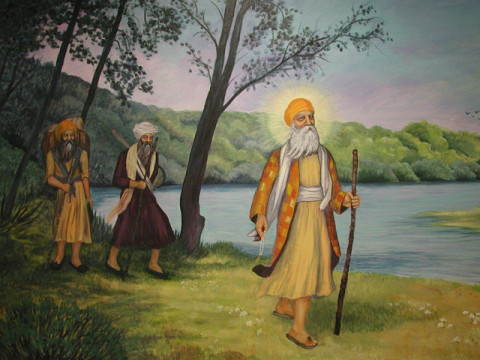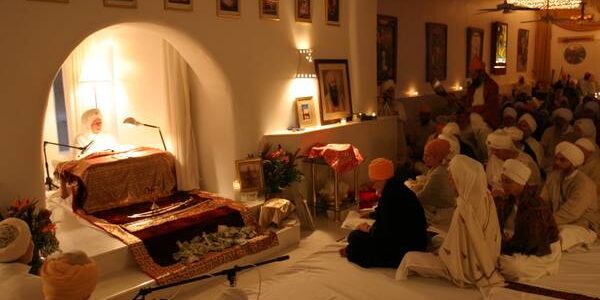by SS Gurukirn Kaur Khalsa, Phoenix, AZ
From the earliest days of his ministry, Guru Nanak’s approach to spreading his God-given message was very simple. Accompanied by his minstrel Mardana, he walked from village to village throughout much of India and many surrounding countries. There he would sit down under a tree, request Mardana to play, and begin to sing. His songs were filled with such poetic beauty and depth of meaning that the villagers could not help but gather around him and listen in awe.
Those who felt their soul’s longing satisfied by the Guru’s shabds (sacred songs) came to be known as shishya, or disciples. Wherever Guru Nanak went, he requested his followers to establish dharamsalas (abodes of dharma) where they could congregate to sing God’s praises. Thus, from the beginning, the most essential aspects of what developed into the Gurdwara service were in place: the sense of awe inspired by the presence of the Guru, the transformation achieved by praising God’s Name, and the magnified effect of gathering in a holy congregation open to all.
“When somebody comes to the House of the Guru, one comes in the most beautiful way possible… It is not where you are, it is not what you are, it is what you project.’…In essence, it is how you project beyond…You rise and consolidate yourself in the morning, dress, look at yourself in the mirror, and all the time your thought is, ‘I am going to the Guru’s house. I am going to present myself before the Guru.’ That is worth a million meditations.”—The Siri Singh Sahib (1977)
At the time of Guru Hargobind the dharamsalas began to be known as gurdwaras (gates of the Guru). The change reflected the development of the faith by Guru Arjan Dev. He had taken the original sacred composition book of Guru Nanak, the pothi, to which had been added the compositions of subsequent Gurus, and compiled their sacred writings and those of other saints into a granth, which he installed in the Harimandir Sahib in Amritsar in 1604. From that time on, copies of the Granth were piously transcribed and devotees carried them on their heads to install in their respective dharamsalas. Eventually, the granth became known was as the Granth Sahib and was treated as a holy embodiment of the Gurus’ revealed utterances. The dharamsal where the Granth Sahib was kept became known as a gurdwara.
A Million Meditations
Just as the early Sikhs were in awe in the presence of Guru Nanak, so the Sikh today experiences a sense of anticipation in coming into the presence of the Guru in gurdwara. Siri Singh Sahib states, “When somebody comes to the House of the Guru, one comes in the most beautiful way possible… It is not where you are, it is not what you are, it is what you project.’…in essence, it is how you project beyond… You rise and consolidate yourself in the morning, dress, look at yourself in the mirror, and all the time your thought is, ‘I am going to the Guru’s house. I am going to present myself before the Guru.’ That is worth a million meditations.” (KWTC 1977 Vol. 2 p. 424)
When you go inside the Gurdwara, through the Guru’s gate, you have affirmed your commitment to the elevation of your soul. You receive the nectar of the Gurbani, which produces an internal state of bliss. The power of the Sadh Sangat (Company of the Holy) magnifies your “chance to uplift the flow of your own spirit.” (KWTC 1977 Vol. 2 p. 354) You make your self that sacred abode from which resounds the Guru’s Holy Word, and you become as Guru Nanak.
About the Author

SS Gurukirn Kaur Khalsa became an ordained Minister of Sikh Dharma in 1974. She has served the Guru Nanak Dwara community in Phoenix, AZ, for many years and has been part of the team working on the construction of the new Gurdwara, scheduled to open in 2016. Actively involved in interfaith activities, she serves on the Arizona Interfaith Movement board. She is a member of the Ambassador Advisory Council for the Parliament of the World’s Religions. As a watercolor painter, she has lent her artistic eye to color and design decisions for the new Gurdwara.

